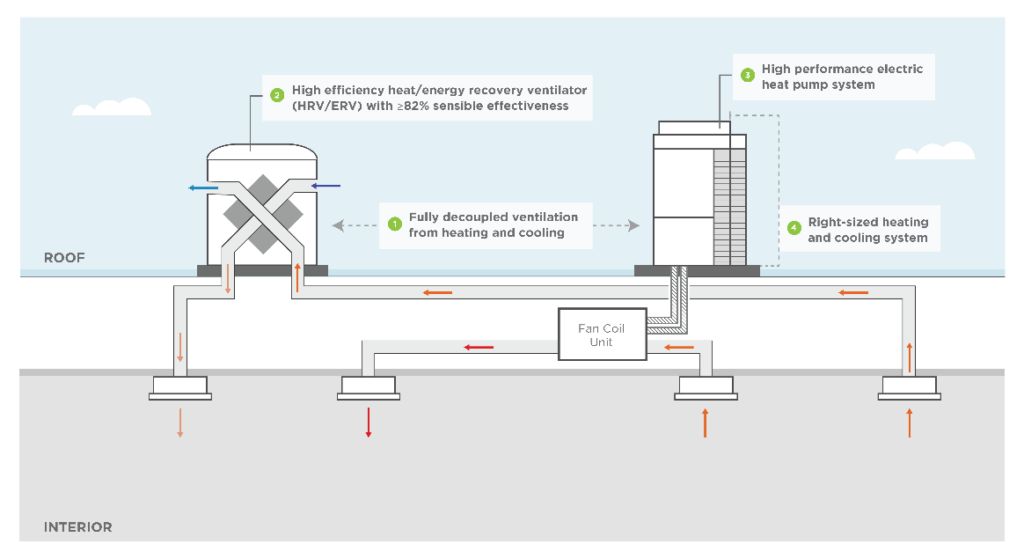This blog was written by Maria Murphy, senior program manager at Northwest Energy Efficiency Alliance.
Designing commercial buildings to achieve net zero does not require a compromise on indoor air quality. For less efficient HVAC solutions, providing inhabitants with filtered indoor air can result in a significant spike in energy use. This escalation of energy use and operational cost typically stems from the increased fan energy required to provide building occupants with clean, ventilated air. However, recent studies show that this does not have to be the case. Very high efficiency dedicated outside air systems (DOAS) are a tested, all-electric, and readily available HVAC design approach that lets building designers have it all: increased ventilation rates, lower energy costs, and net-zero readiness.
Designed, vetted, and tested by the nonprofit Northwest Energy Efficiency Alliance (NEEA)—in partnership with HVAC industry experts—over the last seven years, the very high efficiency DOAS approach combines high-efficiency equipment with design best practices, including:
- Fully separating the ventilation function from the heating and cooling
- Using a high-efficiency heat or energy recovery ventilator (HRV/ERV) with 82% or greater sensible effectiveness
- Pairing the HRV/ERV with an electric heat pump system that meets ENERGY STAR® performance standards
- Right-sizing the heating and cooling equipment
In this approach, the ENERGY STAR-rated electric heat pump provides increased energy savings, improved temperature control, and year-round enhanced comfort for building occupants. And, with a wide variety of equipment options available to choose from, designers on the path to net zero have plenty of flexibility while addressing the particular needs of their building.
The high-efficiency ventilation system required for the very high efficiency DOAS approach pre-heats incoming air by recovering heat from the exhaust air in the winter. In the summer, the system pre-cools the incoming air by rejecting heat to the exhaust air. This process significantly reduces the need for wasteful post-conditioning of ventilation air.
This elevated system performance is not just theoretical. NEEA and a team of HVAC experts completed 12 commercial building demonstration projects that have proven the efficacy of very high efficiency DOAS. These projects verify that this approach significantly reduces customer energy costs and lowers overall commercial building energy use by an average of 48%, while reducing HVAC energy use by an average of 69% when compared to a code-minimum version of the existing equipment, which in many cases is a packaged rooftop unit.
The very high efficiency DOAS approach is as healthy as it is efficient. By fully decoupling the ventilation air from the primary heating and cooling air, very high efficiency DOAS provides filtered, non-recirculated outdoor air to building interiors—minimizing the circulation and introduction of contaminated particles. This is a crucial step to minimizing the spread of viruses and other toxins inside the building, while also reducing entry of harmful particles from outside, including during periods of poor outdoor air quality.
Less efficient HVAC options work hard to provide clean indoor air by significantly increasing ventilation fan rates and, consequently, system energy costs. The very high efficiency DOAS approach can achieve these same higher ventilation rates while using up to 37% less energy than less efficient systems, as demonstrated by a study commissioned by NEEA, and performed by Red Car Analytics and the University of Oregon. In this study, a single-zone rooftop unit and a packaged variable air volume (VAV) system were shown to increase operational energy costs by up to 46%, and a multi-zoned VAV system proved to balloon energy costs by 75% to achieve the same ventilation rates.
With all these built-in efficiencies, very high efficiency DOAS often allows building designers to downsize the heating and cooling system, since it no longer must work so hard to keep occupants comfortable. For designers working to achieve advanced building standards, including net zero, this ability to downsize can be particularly valuable.
Now more than ever, HVAC design approaches—including those that achieve net zero—must thoughtfully balance efficient performance and occupant health. With very high efficiency DOAS, no compromise is needed: Commercial building designers can maintain elevated efficiency performance while providing safe, healthy, and comfortable indoor environments for occupants.
To read more about very high efficiency DOAS, including case studies, research, and technical guides, visit Northwest Energy Efficiency Alliance’s BetterBricks.com.
By NEEA Senior Program Manager, Maria Murphy.
The Northwest Energy Efficiency Alliance (NEEA) is an alliance of more than 140 utilities and energy efficiency organizations working on behalf of more than 13 million energy consumers. NEEA is dedicated to accelerating both electric and gas energy efficiency, leveraging its regional partnerships to advance the adoption of energy-efficient products, services, and practices. For more information, visit neea.org.

